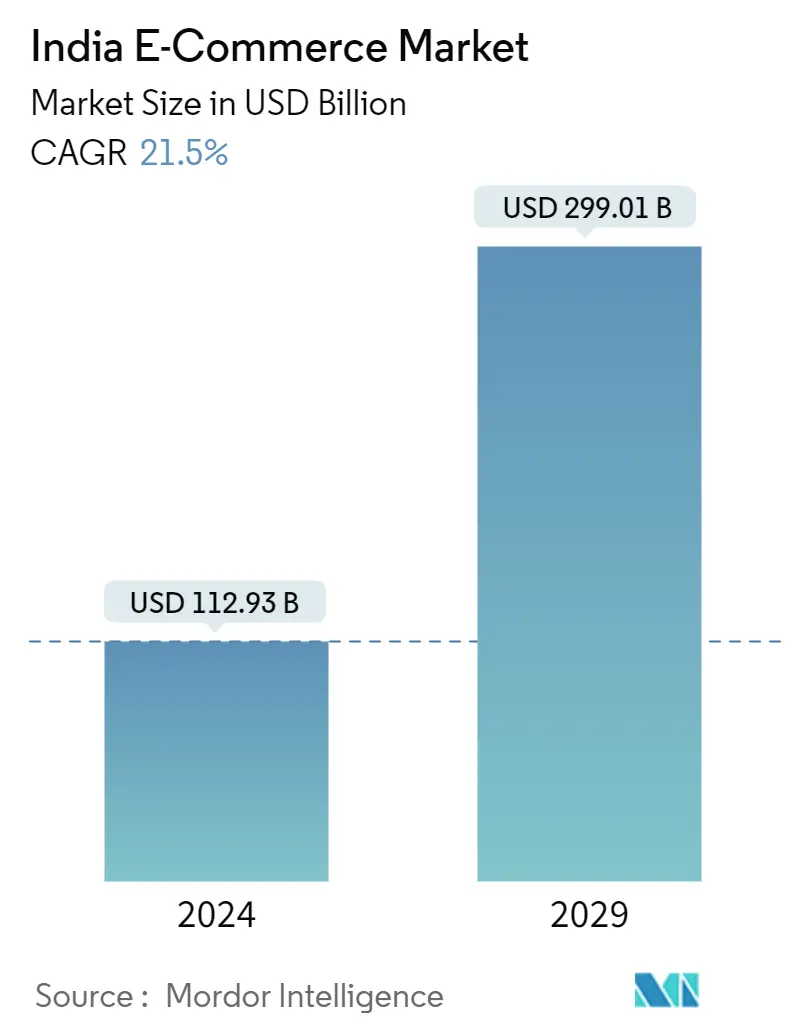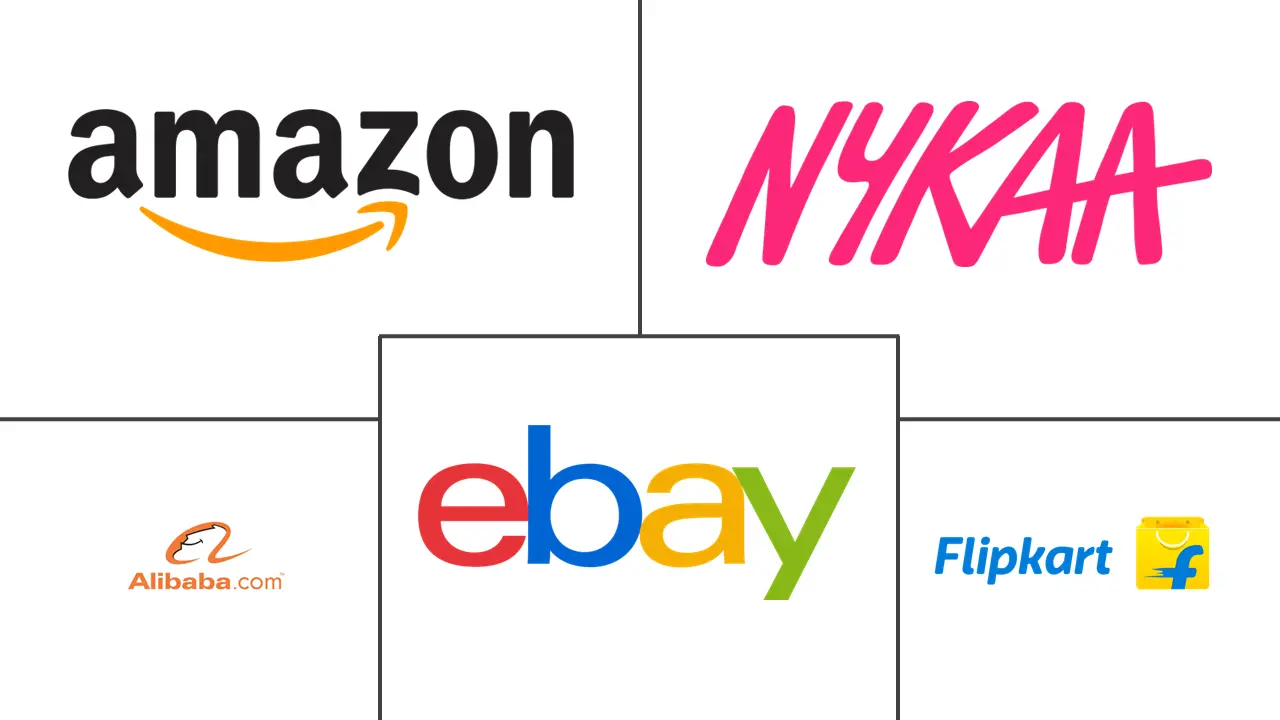Market Size of India E-Commerce Industry

| Study Period | 2019 - 2029 |
| Base Year For Estimation | 2023 |
| Market Size (2024) | USD 112.93 Billion |
| Market Size (2029) | USD 299.01 Billion |
| CAGR (2024 - 2029) | 21.50 % |
| Market Concentration | Medium |
Major Players
*Disclaimer: Major Players sorted in no particular order |
India E-Commerce Market Analysis
The India E-Commerce Market size is estimated at USD 112.93 billion in 2024, and is expected to reach USD 299.01 billion by 2029, growing at a CAGR of 21.5% during the forecast period (2024-2029).
One of the primary factors driving the market's growth is rapid urbanization. Additionally, rising internet penetration and devices such as smartphones, laptops, and tablets to access e-commerce websites boost the market's growth. E-commerce allows businesses to conduct business without maintaining a physical presence, saving money on infrastructure, communication, and overhead.
- The policies introduced by the Government of India, including 100% FDI in B2B E-commerce through the automatic route in the marketplace model of B2C E-commerce, are projected to boost the sector's growth. As per the new FDI policy, online entities, through foreign investment, cannot offer the products sold by retailers in which they hold an equity stake.
- According to the India Brand Equity Foundation (IBEF), the Indian government's Digital India effort aims to drive it into an online economy worth trillions by 2025. It has led to the formation of a new steering group to review and analyze the development of an e-commerce platform for the government.
- The commerce ministry has started a new committee to review the Open Network for Digital Commerce (ONDC) strategy. ONDC is an e-commerce platform that the government is supporting and aims to provide the final shop's infrastructure, which will resemble Flipkart and Amazon. Such developments are expected to drive the studied market.
- According to IBEF, by 2024, online retail penetration will reach 10.7%, up from 4.7% in 2019. Likewise, by 2025, India's internet buyers will number 220 million. According to a Payoneer report, India's e-commerce sector is ranked 9th in the world for cross-border growth. E-commerce in India is expected to grow from 4% of total food and groceries, fashion, and consumer electronics retail sales in 2020 to 8% by 2025.
- Expansion of e-commerce can raise competition in retail markets, increase consumer choice, and motivate and expedite product distribution innovation. However, several competition agencies' recent enforcement and advocacy work have revealed the possibility of anticompetitive behavior in the internet context. Concerns about potential market fragmentation are significant among many organizations that have looked into the topic of e-commerce competition.
- The pandemic-induced lockdown and mobility restrictions represented a significant point for e-commerce in India, driving demand to new highs, bringing new shoppers and sellers into digital platforms, and offering players long-term growth. Containment efforts introduced people to the convenience of online buying and motivated online buyers to buy more, making the Indian e-commerce business one of the significant beneficiaries of the pandemic.
India E-Commerce Industry Segmentation
E-commerce is the buying and selling of goods and services over the Internet through online shopping. However, this term is often used to describe all the seller's efforts in selling products directly to consumers. It begins when potential customers learn about a product, buy it, use it, and ideally maintain lasting customer loyalty.
The Indian e-commerce market is segmented into B2C E-commerce (beauty and personal care, consumer electronics, fashion and apparel, food and beverage, furniture, and home) and B2B E-commerce. The report's scope includes market size and forecasting for B2B and B2C segments, with the B2C channel being further split by application. The market sizes and forecasts are provided in terms of value (USD) for all the above segments.
| By B2C E-commerce | ||||||||
| Market Size (GMV) for the Period of 2018-2028 | ||||||||
|
| By B2B E-commerce | |
| Market Size for the Period of 2018-2028 |
India E-Commerce Market Size Summary
The e-commerce market in India is poised for substantial growth, driven by factors such as rapid urbanization, increased internet penetration, and the widespread use of smartphones, laptops, and tablets. The sector benefits from the government's supportive policies, including 100% foreign direct investment in B2B e-commerce and initiatives like the Digital India campaign, which aims to transform the country into a trillion-dollar online economy. The introduction of platforms like the Open Network for Digital Commerce (ONDC) is expected to further enhance the market's infrastructure, competing with established players like Flipkart and Amazon. The pandemic has accelerated the adoption of e-commerce, with more consumers and sellers turning to digital platforms, thereby boosting long-term growth prospects.
The Indian e-commerce landscape is characterized by intense competition, with major players such as Amazon and Flipkart expanding their reach through customer-centric services. The market is also witnessing a shift towards digital payments, driven by a young, tech-savvy population and the rapid adoption of digital wallets. The consumer electronics sector, including smart wearables and high-definition smart TVs, is experiencing significant growth, providing e-commerce companies with opportunities to expand their product offerings. Investments from global giants like Walmart and Amazon underscore the strategic importance of the Indian market, with substantial capital being funneled into enhancing digital infrastructure and expanding market presence.
India E-Commerce Market Size - Table of Contents
-
1. MARKET INSIGHTS
-
1.1 Market Overview
-
1.2 Industry Attractiveness-Porter's Five Forces Analysis
-
1.2.1 Bargaining Power of Suppliers
-
1.2.2 Bargaining Power of Buyers/Consumers
-
1.2.3 Threat of New Entrants
-
1.2.4 Threat of Substitute Products
-
1.2.5 Intensity of Competitive Rivalry
-
-
1.3 Key Market Trends and Share of E-commerce of Total Retail Sector
-
1.4 Impact of COVID-19 on the E-commerce Sales
-
-
2. Market Segmentation
-
2.1 By B2C E-commerce
-
2.1.1 Market Size (GMV) for the Period of 2018-2028
-
2.1.2 Market Segmentation - by Application
-
2.1.2.1 Beauty and Personal Care
-
2.1.2.2 Consumer Electronics
-
2.1.2.3 Fashion and Apparel
-
2.1.2.4 Food and Beverage
-
2.1.2.5 Furniture and Home
-
2.1.2.6 Other Applications (Toys, DIY, Media, Etc.)
-
-
-
2.2 By B2B E-commerce
-
2.2.1 Market Size for the Period of 2018-2028
-
-
India E-Commerce Market Size FAQs
How big is the India E-Commerce Market?
The India E-Commerce Market size is expected to reach USD 112.93 billion in 2024 and grow at a CAGR of 21.5% to reach USD 299.01 billion by 2029.
What is the current India E-Commerce Market size?
In 2024, the India E-Commerce Market size is expected to reach USD 112.93 billion.

